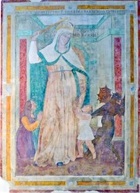

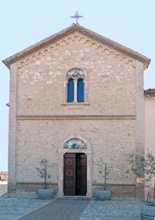
The legend of St Fortunatus, which was probably written in the late 7th century, records that he was “Turritane ecclesia presbiter” (priest of the church of Turrita). He also worked as a farmer, and was renowned for his charity to the poor. When he died (according to tradition in ca. 395), he was buried in a field in a place called “Agello”. His relics were translated soon after to the site of San Fortunato.
The present church was first documented in 1161, and another document from 1216 refers to a programme of re-modelling. The adjoining monastery was governed by a prior appointed by the Abbazia di Santo Stefano in Manciano di Trevi. The church of Santa Lucia, which also depended originally on Santo Stefano, subsequently passed under the direct control of Santa Maria di Turrita.
A document in the archives of the Duomo, Spoleto records that the prior of Santa Maria di Turrita took possession of a vineyard , in località "Arsicciali" (near Fabbri di Montefalco, in the territory of Trevi) in 1221. This and a series of later documents reveal that the monastery was heavily involved in viniculture at this time.
In 1296, Bishop Gerardo Pigolotti of Spoleto suppressed and demolished the priory, which was in decline, and transferred the church to the Cathedral Chapter of Spoleto. The church of Santa Lucia was abandoned at that time.
Exterior
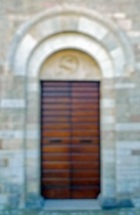
Interior
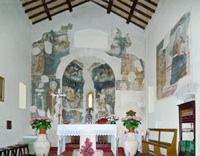
The church has a single aisle, with a semicircular apse that was restored in 2001 and a slightly raised presbytery with a shallow apse.
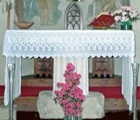
Frescoes (ca. 1333)
These frescoes, which are attributed to the Primo Maestro di Santa Chiara di Montefalco, comprise:
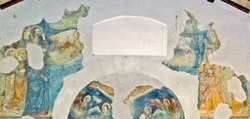
-
✴fragments from the Assumption of the Virgin, above the apse;
-
✴the Crucifixion (with the figure of the Crucified Christ almost completely lost), in the apse:
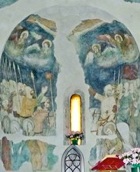
-
✴SS Severus and Fortunatus, to the left of the apse;
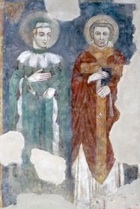
-
✴the upper part of a Madonna and Child, to the right of the apse; and

-
✴the Annunciation, on the left wall.
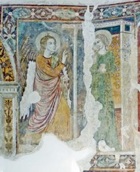
Fresco Fragment (1418)
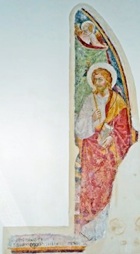
Frescoes (15th century)

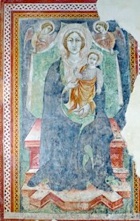
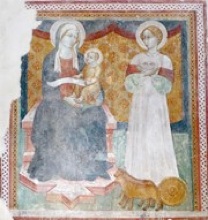
Three frescoes on the right wall are attributed to Bartolomeo da Miranda:
-
✴St Christopher, who carries the baby Jesus across a stream;
-
✴the Madonna and Child, with an inscription that includes part of the date (MCCCC...); and
-
✴the Madonna and Child with St Lucy.
Frescoes (15th century)
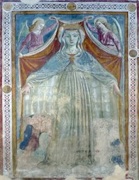
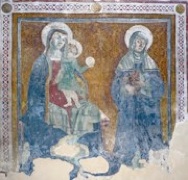
Two adjacent frescoes on the right wall, which seem to be by the same unknown artist, depict:
-
✴the Madonna della Misericordia; and
-
✴the Madonna and Child with St Clare of Montefalco.
Frescoes (1513)
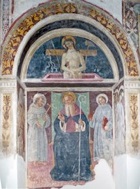
-
✴the Pietà, above;
-
✴SS Antony Abbot enthroned with SS Francis and Antony of Padua;
-
✴St Roch, to the right; and
-
✴SS Cosmas and Damian, to the left.
Madonna del Soccorso (1537)
Vision of St Philip Neri (ca. 1713)
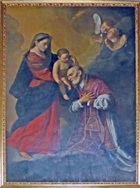
Art from the Church
Madonna and Child (14th century)
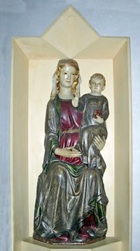
Painted doors from a tabernacle (15th century)
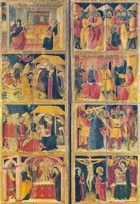
The panel, which was documented in Santa Maria di Turrita in 1829, was moved to the Duomo, Spoleto in 1837. The Commune protested vigorously, and it was returned in 1839. It is now in the Pinacoteca. It is possible that these shutters enclosed a tabernacle in Santa Maria di Turrita that enclosed the statue of the Madonna and Child described above.
Madonna and Child with saints (1488)
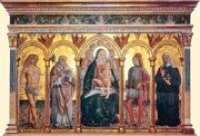
Angelo di Bartolomeo, the rector of Santa Maria di Turrita, and his associates Evangelista di Cecco and Pellegrino di Francesco commissioned this altarpiece from Francesco Melanzio in 1485, but it took some time to complete: it is dated by inscription to 1488. It depicts the Madonna and Child enthroned with SS Sebastian, Fortunatus, Severus and Clare of Montefalco. The altarpiece is now in the Pinacoteca.




